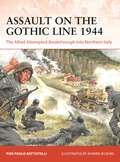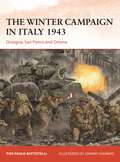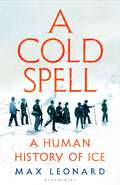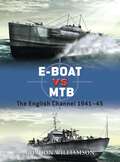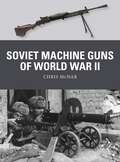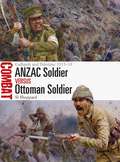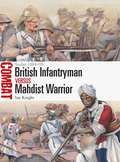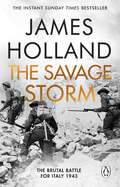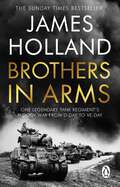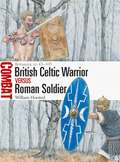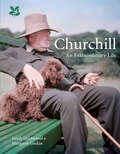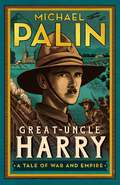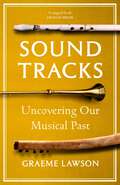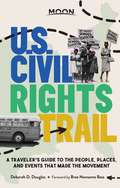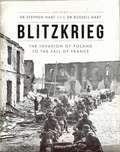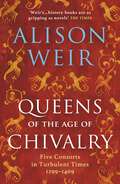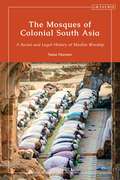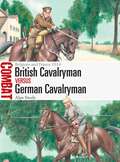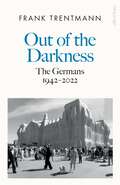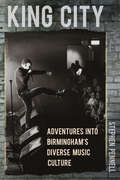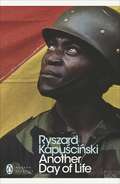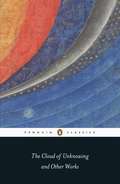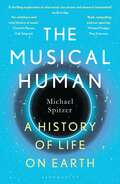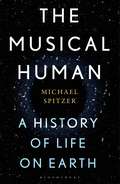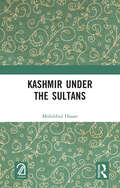- Table View
- List View
Assault on the Gothic Line 1944: The Allied Attempted Breakthrough into Northern Italy (Campaign #387)
by Pier Paolo BattistelliEnjoy a detailed examination of Operation Olive as US, British, Commonwealth and Allied forces seek to smash through the last German defensive line in Italy.The Italian theatre of operations post-summer 1944 was often (and incorrectly) surmised at the time as a quiet sector of World War II, populated with troops who were relieved not to find themselves fighting in North-West Europe. Yet the true nature of the hard fighting that took place here was soon revealed when the Allies began their assault on the Axis Gothic Line defences, known as Operation Olive. In this book, Italian military historian Pier Paolo Battistelli documents the dual Allied offensive spearheaded by American and British units to smash through what was supposed to be the final Axis defensive line in Italy before the Alps. The overall strategic aims of both the Axis and Allied leaders are explored, together with the organization of the forces committed.The expertly researched maps and 3D diagrams guide the reader through the progress of the phased battles in challenging terrain. Photographs and specially commissioned artworks show the soldiers that fought on both sides, including American, Canadian, Indian, Brazilian, Polish, New Zealander, British, German and Italian troops, as well as the materiel they employed. The result is an essential illustrated guide to a fascinating and complex late-war campaign.
The Winter Campaign in Italy 1943: Orsogna, San Pietro and Ortona (Campaign #395)
by Pier Paolo BattistelliA gripping tale of three crucial battles fought at the end of 1943 as Allied forces approached the Gustav Line in Italy.After repulsing the German counter-attack at Salerno in September 1943, the US Fifth Army and British Eighth Army advanced up the Italian Peninsula. By October, the Allied armies had reached the Volturno Line, forcing a critical decision in German strategy: a prolonged defence would be conducted in southern Italy, contesting the Allied advance using the complex terrain features. By mid-November, the two Allied armies were approaching the German defensive lines along the Garigliano and the Sangro rivers. Here, US 5th Army would attack through the Mignano gap towards San Pietro Infine, while British Eighth Army would seize Ortona on the Adriatic coast and Orsogna. A brutal struggle ensued, with the German defenders attempting to hold their positions. The fighting at Ortona in particular (labelled a 'mini Stalingrad') would be particularly grueling for the Canadian forces involved. This fascinating work focuses on several little-known battles fought in Italy following the German withdrawal from the Salerno bridgehead and from Taranto. Maps and diagrams present an easy to follow overview of the multiple operations of this complex campaign. The forces of the opposing sides (including American, German, Canadian, New Zealand and British troops), and the three decisive battles fought in late 1943, are brought vividly to life in period photos and superb battlescene artworks.
A Cold Spell: A Human History of Ice
by Max LeonardTaking us from the beginning of our story to the present day, A Cold Spell examines how ice has shaped our thoughts, actions and societies – and what it means for us that it is rapidly disappearing from our planet'Bracingly original . . . As the earth warms threateningly, there could hardly be a more pertinent time for a story like this' MICHAEL PALIN'A book of limitless fascinations' OLIVIA LAING'A thought-provoking chronicle of humanity . . . Leonard consistently frames ice in surprising and insightful ways, and in doing so lends it a magical quality' GEOGRAPHICALIce has confounded, delighted and fascinated us since the first sparks of art and culture in Europe and it now underpins the modern world. Without ice, we would not feed ourselves or heal our sick as we do, and our towns and cities, countryside and oceans would look very different. Science would not have progressed along the avenues it did and our galleries and libraries would be missing many masterpieces.A Cold Spell uses this vital link to understanding our past to tell a surprising story of obsession, invention and adventure – how we have lived and dreamed, celebrated and traded, innovated, loved and fought over thousands of years. It brings together a sacrificial Incan mummy, Winston Churchill's secret plans for unusual aircraft carriers, strange bones that shook Victorian beliefs about the world and a macabre journey into the depths of the human body. It is an original and unique way of looking at something that is literally all around us, whose loss confronts us daily in the news, but whose impact on our lives has never been fully explored.
E-Boat vs MTB: The English Channel 1941–45 (Duel)
by Gordon WilliamsonAn examination of the 'small boat' war between the Germans and the British in the English Channel.During the Second World War, German E-Boats were so active in the English Channel that the narrow stretch of water became known as 'E-Boat Alley'. To counter the threat of these E-Boats, Britain brought its coastal forces to bear – flotillas of small Motor Torpedo and Gun Boats (MTBs and MGBs) and Motor Launches (MLs). As the Germans sought to maintain their supremacy in Channel waters, they continued to develop their E-Boat designs to accommodate more armor and more firepower. Rather than matching the newer E-Boats for armament, the British developed several types to fulfill the varied roles for which the Kriegsmarine were attempting to use the E-Boat. Illustrated with high-quality photographs and battlescene artworks, this book details this developing conflict, examining the evolution of the boats involved, and covering their battles from fights in the Thames Estuary to the build-up for D-Day.
Soviet Machine Guns of World War II (Weapon #81)
by Chris McNabThis study looks at how the Soviet armed forces developed and deployed a range of machine guns that fitted with their offensive and defensive infantry tactics across six years of total war.In 1939, three machine guns dominated the Red Army's front-line infantry firepower – the DShK 1938 heavy machine gun, the PM M1910 medium/heavy machine gun and the Degtyaryov DP-27, a lighter, bipod-mounted support weapon. Confronted by cutting-edge German technology during the Great Patriotic War (1941–45), the Soviets responded with the development of new weaponry, including the RPD light machine gun, the 7.62×54mmR SG43 medium machine gun and the improved version of the DP-27, the DPM. Taken together, all these weapons gave the Red Army a more practical range of support weapons, better able to challenge the Germans for fire superiority on the battlefield. Fully illustrated, this study explains the technology and the tactics of these machine guns. Noted authority Chris McNab sets out how these machine guns were distributed and tactically applied and provides numerous examples of the weapons in action, from assault teams on the streets of Stalingrad to tank crews struggling for survival at Kursk. The book also reflects upon the weapons' post-war service; many of the machine guns remain in front-line use today. Illustrated with high-quality photographs and specially commissioned artwork, this is a deep analysis of these essential tools of warfare within the Soviet forces.
ANZAC Soldier vs Ottoman Soldier: Gallipoli and Palestine 1915–18 (Combat)
by Si SheppardIn 1915–18, ANZAC and Ottoman soldiers clashed on numerous battlefields, from Gallipoli to Jerusalem. This illustrated study investigates the two sides' fighting men.The Gallipoli campaign of 1915–16 pitched the Australian and New Zealand volunteers known as the ANZACs into a series of desperate battles with the Ottoman soldiers defending their homeland. In August 1915, the bitter struggle for the high ground known as Chunuk Bair saw the peak change hands as the Allies sought to overcome the stalemate that set in following the landings in April. The ANZACs also played a key part in the battle of Lone Pine, intended to divert Ottoman attention away from the bid to seize Chunuk Bair. The Gallipoli campaign ended in Allied evacuation in the opening days of 1916. Thereafter, many ANZAC units remained in the Middle East and played a decisive role in the Allies' hard-fought advance through Palestine that finally forced the Turks to the peace table. The fateful battle of Beersheba in October 1917 pitted Australian mounted infantry against Ottoman foot soldiers as the Allies moved on Jerusalem. In this book, noted military historian Si Sheppard examines the fighting men on both sides who fought at Lone Pine, Chunuk Bair and Beersheba. The authoritative text is supported by specially commissioned artwork and mapping plus carefully chosen archive photographs.
British Infantryman vs Mahdist Warrior: Sudan 1884–98 (Combat)
by Ian KnightIn the early 1880s, Britain intervened in independent Egypt and seized control of the Suez Canal. British forces were soon deployed to Egypt's southern colony, the Sudan, where they confronted a determined and capable foe amid some of the world's most inhospitable terrain. In 1881 an Islamic fundamentalist revolt had broken out in the Sudan, led by a religious teacher named Muhammad Ahmad bin Abd Allah, who proclaimed himself al-Mahdi, 'The Guided One'. In 1884, Mahdist forces besieged the Sudanese capital of Khartoum; Colonel Charles Gordon was sent to the city with orders to evacuate British personnel, but refused to leave. Although the British despatched a relief column to rescue Gordon, the Mahdists stormed Khartoum in January 1885 and he was killed. British troops abandoned much of the Sudan, but renewed their efforts to reconquer it in the late 1890s, in a bloody campaign that would decide the region's fate for generations. Written by leading expert Ian Knight, this fully illustrated study examines the evolving forces, weapons and tactics employed by both sides in the Sudan, notably at the battles of Abu Klea (16–18 January 1885), Tofrek (22 March 1885) and Atbara (8 April 1898).
The Savage Storm: The Heroic True Story of One of the Least told Campaigns of WW2
by James Holland'[A] captivating and dramatic account. . . Drawn from letters and diaries, Holland’s immersive narrative is told through the eye-level perspectives of dozens of subjects. Readers will be enthralled' Publishers Weekly‘Tells the story of the hard, bloody, muddy fighting that filled the rest of 1943… this excellent book reinforces Holland’s reputation as the busiest and most popular military historian of the second world war working today’ Spectator‘A remarkable achievement by a historian at the height of his powers. Holland has successfully illustrated both the significance and the savagery of the Italian campaign... through a powerful and compelling narrative’ Military History Matters_____________________From the bestselling author of Brothers in Arms comes the story of the most pivotal Allies campaign of World War II.With the invasion of France the following year taking shape, and hot on the heels of victory in Sicily, the Allies crossed into Southern Italy in September 1943. They expected to drive the Axis forces north and be in Rome by Christmas. And although Italy surrendered, the German forces resisted fiercely and the swift hoped-for victory descended into one of the most brutal battles of the war.Even though shipping and materiel were already being safeguarded for the D-Day landings, there were still huge expectations on the progress of the invading armies, but those shortages were to slow the advance with tragic consequences. As the weather closed in, the critical weeks leading up to Monte Cassino would inflict a heavy price for every bloody, hard fought mile the Allied troops covered.Chronicling those dark, dramatic months in unflinching and insightful detail, The Savage Storm is unlike any campaign history yet written. James Holland has always recounted the Second World War at ground level, but this version telling brings the story vividly to life like never before. Weaving together a wealth of letters, diaries, and other incredible documents, Holland traces the battles as they were fought - across plains, over mountains, through shattered villages and cities, in intense heat and, towards the end, frigid cold and relentless rain - putting readers at the heart of the action to create an entirely fresh and revealing telling of this most pivotal phase of the war._____________________Praise for James Holland'Impeccably researched and superbly written' Observer'Holland has something new to say.... Filled with insight and detail' Neil Oliver'James Holland is the best of the new generation of WW2 historians' Sebastian Faulks
Brothers in Arms: One Legendary Tank Regiment's Bloody War from D-Day to VE-Day
by James HollandFrom the bestselling author of Normandy '44 and Sicily '43, a brilliant new history of the last days of the war'Seldom is war so vividly described...An assault on the senses...Painful to read, impossible to put down' Gerard DeGroot, The TimesIt took a certain type of courage to serve in a tank in the Second World War. Encased in steel, surrounded by highly explosive shells, a big and slow-moving target, every crew member was utterly vulnerable to enemy attack from all sides. Living - and dying - in a tank was a brutal way to fight a war.The Sherwood Rangers were one of the great tank regiments. They had learned their trade the hard way, in the burning deserts of North Africa. From D-Day onwards, they were in the thick of the action til the war's end. They and their Sherman tanks covered thousands of miles and endured some of the fiercest fighting in Western Europe. Their engagements stretch from the Normandy beaches to the bridges at Eindhoven. They were the first British unit into Germany, grinding across the Siegfried Line and on into the Nazi heartland.Through compelling eye-witness testimony and James Holland's expert analysis, Brothers In Arms brings to vivid life the final bloody scramble across Europe and gives the most powerful account to date of what it was really like to fight in the dying days of World War Two.
British Celtic Warrior vs Roman Soldier: Britannia AD 43–105 (Combat)
by William HorstedAn illustrated study of the British tribal warriors and Roman auxiliaries who fought in three epic battles for control of Britain in the 1st century AD. Following the Roman invasion of Britain in AD 43, the tribes of the west and north resisted the establishment of a 'Roman peace', led in particular by the chieftain Caratacus. Even in the south-east, resentment of Roman occupation remained, exploding into the revolt of Boudicca's Iceni in AD 60. Roman auxiliaries from two particular peoples are known to have taken part in the invasion of Britain: the Tungrians, from what is now Belgium, and the Batavians, from the delta of the River Rhine in the modern Netherlands. From the late 80s AD, units of both the Batavians and the Tungrians were garrisoned at a fort at Vindolanda in northern Britain. The so called 'Vindolanda tablets' provide an unparalleled body of material with which to reconstruct the lives of these auxiliary soldiers in Britain.Featuring full-colour maps and specially commissioned battlescene and figure artwork plates, this book examines how both the British warriors and the Roman auxiliaries experienced the decades of conflict that followed the invasion. Their recruitment, training, leadership, motivation, culture and beliefs are compared alongside an assessment of three particular battles: the final defeat of Caratacus in the hills of Wales in AD 50; the Roman assault on the island of Mona (Anglesey) in AD 60; and the battle of Mons Graupius in Scotland in AD 83.
Churchill: An Extraordinary Life
by Sarah Gristwood Margaret Gaskin National Trust BooksA short illustrated life of one of Britain's most revered people of all time, covering all periods of his life but always returning to his literal and spiritual home, Chartwell.
Great-Uncle Harry: A Tale of War and Empire
by Michael PalinFrom the time, many years ago, when Michael Palin first heard that his grandfather had a brother, Harry, who died in tragic circumstances, he was determined to find out more about him.The quest that followed involved hundreds of hours of painstaking detective work. Michael dug out every bit of family gossip and correspondence he could. He studied every relevant official document. He tracked down what remained of his great-uncle Harry's diaries and letters, and pored over photographs of First World War battle scenes to see whether Harry appeared in any of them. He walked the route Harry took on that fatal, final day of his life amid the mud of northern France. And as he did so, a life that had previously existed in the shadows was revealed to him.Great-Uncle Harry is an utterly compelling account of an ordinary man who led an extraordinary life. A blend of biography, history, travelogue and personal memoir this is Michael Palin at his very finest.___________________________________________PRAISE FOR EREBUS:'Beyond terrific. I didn't want it to end.' BILL BRYSON'Magisterial . . . Palin brings energy, wit and humanity to a story that has never ceased to tantalise people.' THE TIMES'Everybody's talking about it . . . A brilliant book.' CHRIS EVANS'I absolutely loved it: I had to read it at one sitting.' LORRAINE KELLY
Sound Tracks: Uncovering Our Musical Past
by Graeme LawsonA transporting voyage of archaeological discovery: Sound Tracks unearths instruments from around the world and across time, releasing the past's musical secrets for the first time. ‘A thrilling journey into the sonic richness of human experience’ PHILIP BALL, author of The Music Instinct‘A magical book’ FRANCIS PRYOR, author of Britain BCFrom the present day back to the dawn of time, from dark caves and murky swamps to open deserts and ocean depths, here is the history of humankind's relationship with music in fifty detective stories.We see a child’s delight in Peru in AD 700, playing with a water-filled pot that chirps like a bird; we shiver with a lonely soldier sending trumpet signals to the next watchtower on Hadrian's Wall; we sway to the stately rhythms of the 64 bells buried in a tomb in China in the 5th century BC. And on this grand tour, we learn that music is part of what makes us human – a way of commemorating our pasts, communicating with others and shaping our lives.Brimming with astonishing insights, Sound Tracks provides an enthralling alternative history of humanity in which the silences of the past are filled with a glorious treasure hoard of vanished sounds and voices.‘Piles revelation upon revelation to shed a completely new perspective on the tools we use for making music’ NORMAN LEBRECHT, author of Why Beethoven‘Lawson has brilliantly conjured up the sounds of 30,000 years of human history’ DAVID ABULAFIA, Professor Emeritus of Mediterranean History
Moon U.S. Civil Rights Trail: A Traveler's Guide to the People, Places, and Events that Made the Movement (Travel Guide)
by Deborah D. DouglasThe U.S. Civil Rights Trail offers a vivid glimpse into the story of Black America's fight for freedom and equality. From eye-opening landmarks to celebrations of triumph over adversity, experience a tangible piece of history with Moon U.S. Civil Rights Trail.Flexible Itineraries: Travel the entire trail through the South, or take a weekend getaway to Charleston, Birmingham, Jackson, Memphis, Washington DC, and more places significant to the Civil Rights MovementHistoric Civil Rights Sites: Learn about Dr. King's legacy at the Lorraine Motel in Memphis, be transformed at the small but mighty Emmett Till Intrepid Center, and stand tall with Little Rock Nine at their memorial in ArkansasThe Culture of the Movement: Get to know the voices, stories, music, and flavors that shape and celebrate Black America both then and now. Take a seat at a lunch counter where sit-ins took place or dig in to heaping plates of soul food and barbecue. Spend the day at museums that connect our present to the past or spend the night in the birthplace of the bluesExpert Insight: Award-winning journalist Deborah Douglas offers her valuable perspective and knowledge, including suggestions for engaging with local communities by supporting Black-owned businesses and seeking out activist groupsTravel Tools: Find driving directions for exploring the sites on a road trip, tips on where to stay, and full-color photos and maps throughoutDetailed coverage of: Charleston, Atlanta, Selma to Montgomery, Birmingham, Jackson, the Mississippi Delta, Little Rock, Memphis, Nashville, Raleigh, Durham, Virginia, and Washington DCForeword by Bree Newsome Bass: activist, filmmaker, and artist Journey through history, understand struggles past and present, and get inspired to create a better future with Moon U.S. Civil Rights Trail.
Blitzkrieg: The Invasion of Poland to the Fall of France
by Stephen A. Hart Russell HartA fascinating study of the devastating new form of warfare that redrew the map of Europe in the opening year of World War II, bringing about the military collapse of three modern industrialized armies. On 1 September 1939, Nazi Germany launched the invasion of Poland, employing a new type of offensivewarfare: Blitzkrieg. So named by Allied observers because of the shock and rapidity of its effects, this newapproach was based on speed, manoeuvrability and concentration of firepower. The strategy saw startlingsuccess as the panzer divisions, supported by Stuka dive-bombers, spread terror and mayhem, reachingWarsaw in just one week. Aided by the intervention of the Soviet Union in the east, the campaign was overin a mere 36 days.This astonishing feat was followed by Operation Weserübung, the invasion of Denmark and then Norway in1940, the first joint air-sea-land campaign in the history of warfare. Even more striking an achievement wasthe swift and conclusive defeat of France during May–June 1940. Refusing to let its forces dash themselvesagainst the fortifications of the Maginot Line, Germany instead sent its divisions through neutral Belgiumand northern France in Fall Gelb ('Case Yellow'), destroying Allied resistance and pursuing the remnant ofthe British and French forces to Dunkirk in an audacious and devastatingly effective assault. During thecourse of Fall Rot ('Case Red') over the following 20 days, German forces pressed the attack and by 25 Junehad forced France's leaders into a humiliating capitulation.Illustrated throughout with detailed maps, artwork and contemporary photographs, Blitzkrieg: TheInvasion of Poland to the Fall of France tells the story of these first breakneck attacks, examining the armedforces, leaders, technology, planning and execution in each campaign as well as the challenges faced by theGermans in the pursuit of this new and deadly form of warfare.
Queens of the Age of Chivalry (England's Medieval Queens #3)
by Alison WeirThe third volume of Alison Weir’s magisterial history of the queens of medieval England.‘Weir’s history books are as gripping as novels’ The TimesMedieval queens were seen as mere dynastic trophies – yet, as Alison Weir shows in this group biography, many of the Plantagenet queens of the High Middle Ages dramatically broke away from the restrictions imposed on their sex.Using personal letters and fascinating sources, Weir evokes the lives of these five extraordinary women: Marguerite of France, Isabella of France, Philippa of Hainault, Anne of Bohemia and Isabella of Valois. At the same time, she recreates a truly astonishing period of history – the turbulent, brutal Age of Chivalry.‘Places the reader in the midst of…complex, gripping events, telling the stories of five royal wives who lived through them’ BBC History‘Weir is an excellent storyteller’ Spectator
The Mosques of Colonial South Asia: A Social and Legal History of Muslim Worship (Library of Islamic South Asia)
by Sana HaroonIn a series of legal battles starting in 1882, South Asian Muslims made up of modernists, traditionalists, reformists, Shias and Sunnis attempted to modify the laws relating to their places of worship. Their efforts failed as the ideals they presented flew in the face of colonial secularism. This book looks at the legal history of Muslim endowments and the intellectual and social history of sectarian identities, demonstrating how these topics are interconnected in ways that affected the everyday lives of mosque congregants across North India. Through the use of legal records, archives and multiple case studies Sana Haroon ties a series of narrative threads stretching across multiple regions in Colonial South Asia.
British Cavalryman vs German Cavalryman: Belgium and France 1914 (Combat)
by Alan SteeleFully illustrated, this book casts light on the utility and role of the German and British cavalry in the early stages of World War I on the Western Front.In the early months of World War I, before the fighting degenerated into static trench warfare, there was a brief period of mobile combat as the German Army advanced through Belgium and northern France, forcing the French and British forces facing them to retreat. Both sides in the escalating conflict deployed substantial numbers of cavalry units to screen their infantry forces, conduct reconnaissance and harness their superior mobility to undertake aggressive combat operations. In the summer of 1914, the British cavalry had the difficult task of covering the withdrawal of the British Expeditionary Force and the German cavalry, the equally demanding task, after weeks of combat and forced marches, of maintaining contact with a rapidly retiring enemy.In this book a comparative assessment is made of each side's doctrine, organization, equipment and training, followed by a detailed analysis of their actual performance in three key encounter actions: Casteau/Soignies (22 August), Cérizy/Moÿ (28 August) and Le Montcel/Frétoy (7 September). This analysis is supported by carefully chosen photographs and specially commissioned full-colour artwork and maps.
Out of the Darkness: The Germans, 1942-2022
by Frank TrentmannA groundbreaking new history of the people at the centre of Europe, from the Second World War to todayIn 1945, Germany lay in ruins, morally and materially. The German people stood condemned by history, responsible for a horrifying genocide and a war of extermination. But by 2015 Germany looked to many to be the moral voice of Europe, welcoming almost one million refugees. At the same time, it pursued a controversially rigid fiscal discipline and made energy deals with a dictator. Many people have asked how Germany descended into the darkness of the Nazis, but this book asks another vital question: how, and how far, have the Germans since reinvented themselves?Trentmann tells the dramatic story of the Germans from the middle of the Second World War, through the Cold War and the division into East and West, to the fall of the Berlin Wall and the reunited nation's search for a place in the world. Their journey is marked by extraordinary moral struggles: guilt, shame and limited amends; wealth versus welfare; tolerance versus racism; compassion and complicity. Through a range of voices - German soldiers and German Jews; environmentalists and coal miners; families and churches; volunteers, migrants and populists - Trentmann paints a remarkable and surprising portrait over 80 years of the conflicted people at the centre of Europe.
King City: Adventures into Birmingham's Diverse Music Culture
by Stephen PennellBirmingham has a tradition of individualism and experimentation, giving rise to a fragmented but innovative culture. This applies to the city’s contemporary music scene just as it does to the rest of its cultural heritage, which explains why the Birmingham sound is hard to define. Whereas other cities are known for a certain sound, this city celebrates its diversity. In this new decade, the plethora of exciting indie bands, sick rappers and emotive singer-songwriters are surrounded by a collective of DJs, producers, promoters, venues, bloggers and vloggers who promote them. There’s an agglomeration building, coalescing around the Birmingham Music Awards, whose mission is to amplify this uprising to the world. In this book, Stephen Pennell’s reviews and musings shine a light on Birmingham’s finest up-and-coming performers playing the city’s most iconic venues, taking us on a unique journey around Birmingham’s music scene.
Another Day of Life (Forsyte chronicles)
by Ryszard Kapuscinski William Brand'This is a very personal book, about being alone and lost'. In 1975 Kapuscinski's employers sent him to Angola to cover the civil war that had broken out after independence. For months he watched as Luanda and then the rest of the country collapsed into a civil war that was in the author's words 'sloppy, dogged and cruel'. In his account, Kapuscinski demonstrates an extraordinary capacity to describe and to explain the individual meaning of grand political abstractions.
The Cloud of Unknowing and Other Works
by A. SpearingContains The Cloud of Unknowing, The Mystical Theology of Saint Denis, The Book of Privy Counselling, and An Epistle on Prayer. Against a tradition of devotional writings which focussed on knowing God through Christ's Passion and his humanity, these texts describe a transcendent God who exists beyond human knowledge and human language. These four texts are at the heart of medival mystical theology in their call for contemplation, calm, and above all, love, as the way to understand the Divine.
The Musical Human: A History of Life on Earth
by Michael Spitzer'Michael Spitzer has pulled off the impossible: a Guns, Germs and Steel for music' Daniel Levitin 165 million years ago saw the birth of rhythm.66 million years ago was the first melody.40 thousand years ago Homo sapiens created the first musical instrument.Today music fills our lives. How we have created, performed and listened to this music throughout history has defined what our species is and how we understand who we are. Yet music is an overlooked part of our origin story. The Musical Human takes us on an exhilarating journey across the ages – from Bach to BTS and back – to explore the vibrant relationship between music and the human species. With insights from a wealth of disciplines, world-leading musicologist Michael Spitzer renders a global history of music on the widest possible canvas, looking at music in our everyday lives; music in world history; and music in evolution, from insects to apes, humans to AI. Through this journey we begin to understand how music is central to the distinctly human experiences of cognition, feeling and even biology, both widening and closing the evolutionary gaps between ourselves and animals in surprising ways.The Musical Human boldly puts the case that music is the most important thing we ever did; it is a fundamental part of what makes us human.
The Musical Human: A History of Life on Earth
by Michael Spitzer"Michael Spitzer has pulled off the impossible: a Guns, Germs and Steel for music." --Daniel Levitin A colossal history spanning cultures, time, and space to explore the vibrant relationship between music and the human species.165 million years ago saw the birth of rhythm.66 million years ago was the first melody.40 thousand years ago Homo sapiens created the first musical instrument.Today music fills our lives. How we have created, performed and listened to this music throughout history has defined what our species is and how we understand who we are. Yet music is an overlooked part of our origin story. The Musical Human takes us on an exhilarating journey across the ages – from Bach to BTS and back – to explore the vibrant relationship between music and the human species. With insights from a wealth of disciplines, world-leading musicologist Michael Spitzer renders a global history of music on the widest possible canvas, looking at music in our everyday lives; music in world history; and music in evolution, from insects to apes, humans to AI. Through this journey we begin to understand how music is central to the distinctly human experiences of cognition, feeling and even biology, both widening and closing the evolutionary gaps between ourselves and animals in surprising ways.The Musical Human boldly puts the case that music is the most important thing we ever did; it is a fundamental part of what makes us human.
Kashmir Under the Sultans
by Mohibbul HasanKashmir Under Sultans introduces the reader to a subject that begins with the foundation of the Sultanate and ends with the conquest of Kashmir by Akbar. During the Sultanate period, Kashmir had achieved a high standard of culture, but with the disappearance of her independence, her culture gradually declined. Poets, painters, and scholars had to leave the Valley and seek their livelihood elsewhere owing to the absence of local patronage. They then entered the service of the Mughal emperors and were added to the court, thereby lessening the cultural impoverishment of Kashmir. The book encloses political, social, economic and cultural activities that had a lasting influence on the Kashmir Valley in that period. It is of considerable value to social historians as Professor Mohibbul Hasan offers insights into political and cultural currents and crosscurrents in Kashmir. This title is co-published with Aakar Books. Print editions not for sale in South Asia (India, Sri Lanka, Nepal, Bangladesh, Pakistan and Bhutan)
